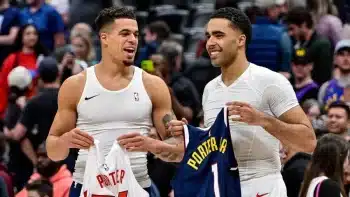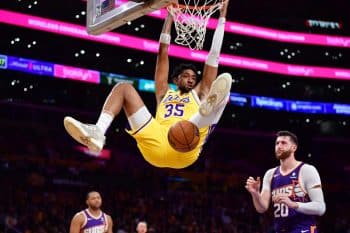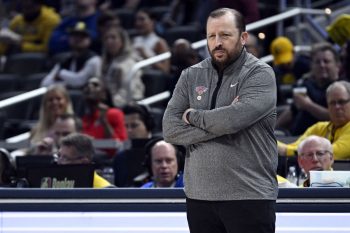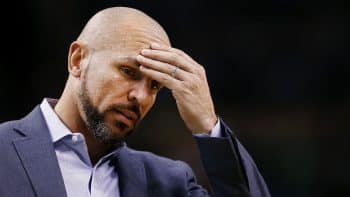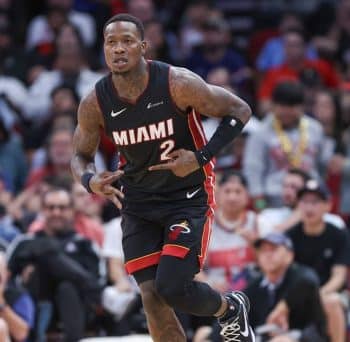NBA
NBA PM: The Evolution of the Seven-Footer

The Rise of the Three-pointer and Subsequent Evolution of Seven-Footers
The NBA introduced a potentially revolutionary rule change at the start of the 1979-80 season: shots made from a certain distance (ranging from 22 feet in the corners to 23.75 feet at the top of the key) would be worth three points.
The new rule didn’t have much of an impact initially and many fans and pundits didn’t think it would last.
In those early years, many teams essentially ignored the newly painted lines on the court and rarely attempted shots from downtown – other than the occasional half-court heave to close out a quarter.
For instance, the powerhouse Los Angeles Lakers won the NBA championship in 1981-82 and, over the course of the entire 82-game regular season, attempted a grand total of 94 three-pointers. They made just 13 of them attempts, or 13.8 percent. Magic Johnson led the team with six makes. They made just two more during their entire postseason run.
And it wasn’t as if the Lakers were an anomaly. Only one team in the entire league (the Indiana Pacers) made more than 100 three-pointers over the 82-game regular season in 1981-82.
Even a decade after its introduction, the three-point shot wasn’t a major difference-maker. Still, eventually, the shot started to catch on for certain teams and certain players. There were typically a few guards on each team that would be classified as ‘three-point specialists.’
Let’s fast-forward 25-plus years, shall we?
Simply put, the three-point shot has revolutionized the way today’s game is played. Consider the story of the 2016-17 Houston Rockets. At 22-8, they possess the fourth-best record in the entire league and have been one of the season’s most pleasant surprises. On a related note, they are on pace to shatter every team-related three-point record known to man.
At this time last month, no NBA team had ever attempted more than 49 threes in a single regular-season game. (The Dallas Mavericks launched 49 treys in a win over the New Jersey Nets back in March of 1996 and that record remained for more than 20 years).
Then, last month, on the day after Thanksgiving, the Rockets broke that long-standing record by attempting 50 three-pointers in a win over the Sacramento Kings. But the Rockets were just getting warmed up. Last Friday night, they broke their own newly-minted, all-time record by launching 61 three-point attempts against the New Orleans Pelicans. The next night in Minnesota, the Rockets attempted 51 triples.
Yes, in the nearly 40 years and over 45,000 games played since the NBA introduced the three-pointer, no team had ever attempted 50 treys in a single game. Then, here come the Rockets, who have now done it three times in less than a month.
It is important to note that the Rockets are not some abnormal outlier either. Many teams in today’s NBA are incredibly reliant on long-distance shooting, including many of the league’s elite contenders. The two teams that led the NBA in made three-pointers during the 2015-16 regular season were the Golden State Warriors and the Cleveland Cavaliers – the two teams that ultimately ended up squaring off in the NBA Finals.
During that 1981-82 season discussed earlier, the league-leader in made three-pointers was a point guard named Mike Bratz. He made a total of 57 treys, tops in the NBA. Last season, 145 players made at least 60 three-pointers, including Steph Curry, who made 402.
It isn’t simply the attempts that have skyrocketed, it’s also the efficiency. In 1981-82, 21 of the 23 teams in the league shot less than 30 percent from behind-the-arc. The Pacers led the NBA in three-point percentage at 32.6 percent that season.
In 2016-17, all 30 teams are shooting above 30 percent from downtown and 29 of the 30 are shooting above 32.6 percent.
While the entire league is obviously more three-point happy than it has ever been, arguably the greatest surge can be seen in the evolution of the league’s big men.
For most of the last three decades, three-point territory remained a foreign and impenetrable land for NBA bigs. Lumbering centers and burly power forwards were instructed to run down low and camp out in the post. According to Basketball-Reference.com, over the first nine seasons of the NBA’s three-point era, from 1979-80 through 1987-88, no player listed at seven-feet or taller made more than three three-pointers in any season.
In 1988-89, Manute Bol made 20 three-pointers. Bol holds the record among seven-footers for most made three-balls in the 1980s with those 20 threes. Next on the list is Ralph Sampson, who made a grand total of eight.
Well, we now live in a different world.
The 2016-17 season is less than two months old and most teams have yet to play even 30 games; already, 10 different seven-footers have made at least 15 three-pointers at this early stage of the season.
Looking back, the evolution began in the mid-90s, as the European influences began to make their way overseas. The first seven-footer to make more than 20 three-pointers in a season was Vlade Divac of the Lakers in 1993. Then, in 1996, Portland’s Arvydas Sabonis set a new record with 49 triples.
The game continued to expand at the dawn of this century. Wang Zhizhi, by way of China, made 48 threes for the Mavs in 2003. Yi Jianlian also made 48 for the Lakers in 2009. Andrea Bargnani of Italy knocked down 100 three-pointers as a rookie in Toronto in 2007. Per Basketball-Reference, Spencer Hawes became the first American-born seven-footer to make 40 three-pointers in a single season as a Sacramento King in 2009.
Still, the true game-changer was Germany’s Dirk Nowitzki, who forever revolutionized the way we view the league’s taller players. Dirk, the sixth-leading scorer in NBA history, has made 1,707 threes in his storied career, which is by far the most among all seven-footers (Bargnani is currently second with 627).
The Next Step in the Evolution
Nowitzki has averaged 95 made three-pointers per season over his 19-year career and has made more triples than any player seven feet or taller each season this decade. However, that streak will be snapped this year. Nowitzki is dealing with a nagging Achilles injury that has limited him to just five games this season.
The current leader in made three-pointers among bigs is actually a player who measures in at 7’3.
New York’s Kristaps Porzingis has knocked down 60 three-pointers this season. Memphis’ Marc Gasol ranks second (46) and Brooklyn’s Brook Lopez is third (44).
Porzingis and his contemporaries, such as Karl-Anthony Towns and Joel Embiid, represent the most recent stages of the ever-evolving big man in the NBA. They are giant sharp-shooters who are athletic and nimble enough to put the ball on the floor and create scoring opportunities for themselves and others, yet long and strong enough to guard the rim and protect the paint on the defensive end of the floor.
Porzingis played his 100th career game on Tuesday night, a victory over the Pacers at MSG. The NBA has been around for 70 years now, but we have never quite seen a player start their career the way Porzingis has. His all-around versatility separates him from the pack.
Prior to Porzingis, no player in NBA history had ever made more than 120 three-pointers and blocked more than 110 shots over the first 100 games of his career. Well, KP has obliterated that record, having already knocked down 141 three-pointers and blocked 185 shots.
Porzingis is up to 60 made three-pointers this season, which means he has more threes than noted marksmen such as Kevin Durant, Kyle Korver and his own teammate Carmelo Anthony.
He also has more blocks (51) than DeAndre Jordan, DeMarcus Cousins and Dwight Howard.
Per NBA.com, Porzingis’ DFG% (what opponents are shooting at the rim when being defended by him) currently stands at 40.6 percent, which ranks first in the league among qualified players – ahead of such defensive monsters as Rudy Gobert (41.7 percent) and Hassan Whiteside (45.8).
Porzingis is averaging over two made three-pointers per game and is shooting over 39 percent from downtown. That’s a higher three-pointer percentage than James Harden, Klay Thompson and Damian Lillard.
Porzingis has grabbed 213 rebounds this season, which is more boards than LeBron James, Robin Lopez and Marc Gasol.
You get the idea.
Oh, by the way, Porzingis doesn’t turn 22 years old until next August.
The New CBA Will Help Teams Re-sign Talented Bigs
Let’s continue to use Porzingis as an example. New Yorkers are obviously hopeful that they will be able to continue watching Porzingis grow and develop in as a member of the Knicks. Earlier this month, they got encouraging news.
The NBA’s new, soon-to-be ratified collective bargaining agreement is great news for Porzingis and other up-and-coming stars because it will make him a whole lot of money. But it’s also good for the Knicks, and their KP-loving fanbase, because it greatly increases the likelihood of Porzingis spending the vast majority of his career in New York.
The first impact Porzingis will see is an immediate raise, which kicks in next season. As part of the new CBA, current rookie-scale contracts get significant increases. For KP, his initial contract was set to pay him $4.5 million in 2017-18 and $5.6 million in 2018-19. Instead, he will now likely make north of $5 million next season and $7.2 million in 2018-19.
Also, Porzingis is now in line to sign a massive extension. In the summer of 2019, once he has completed four years of NBA service, he will be eligible to sign a huge extension that may be worth close to $200 million.
Star players staying with the team that drafted them through the first two contracts of their career is fairly common today, even under the current CBA, due to the financial benefits of doing so. However, what will change under the new CBA is that elite, superstar players will be highly incentivized to stay with their current team on their third contracts as well.
After seeing top-tier players such as LeBron James, Chris Paul, Carmelo Anthony and, most recently, Kevin Durant switch teams in the heart of their respective primes, the league and the players’ union set out to create a major “home-court advantage” that would entice superstars to stay put. Thus, under the new CBA, teams looking to re-sign a player will be able to offer significantly more money (not only contracts longer in length, but also a far greater percentage of the salary cap starting the very first season) than competing franchises.
The qualifications for this new designated player exception are extremely difficult to reach. As reported by our Eric Pincus, to qualify a player must be entering their eighth or ninth season and have remained with the team that drafted them. They also need to be named to any of the three All-NBA teams or as Defensive Player of the Year in either the season preceding the extension or two of the three prior seasons. It will also apply to the league’s Most Valuable Player in any of the three seasons before the extension.
This means that superstars will have every incentive to stay with their original team through their third contract and avoid testing free agency at any point in their prime.
Obviously, we are looking very far down the road, but if Porzingis does develop into the kind of All-NBA caliber player that Phil Jackson and the Knicks believe he is destined to be, the odds are now greatly increased that he will stay in New York through 2030.
Teams can now watch their seven-footers evolve and dominate in new ways without constantly worrying that their talented big man will leave as soon as free agency comes around.
